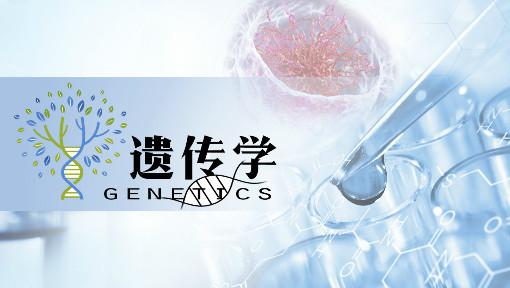

| 开课平台 | 爱课程(中国大学MOOC) |
|---|---|
| 开课高校 | 西北农林科技大学 |
| 开课教师 | Xiayan LIU、Ruolin YANG、安丽君、邵景侠 |
| 学科专业 | 理学生物科学类 |
| 开课时间 | 2021/07/26 - 2021/11/15 |
|---|---|
| 课程周期 | 16 周 |
| 开课状态 | 已结课 |
| 每周学时 | - |
Genetics explores the inheritance and variation of genes. The application of the laws of inheritance can be traced back to the domestication of crops and livestock by our prehistoric ancestors. In recent years, with the breakthroughs in new technologies such as next-generation sequencing and gene editing, the cutting-edge development of genetics is changing rapidly and constantly reshaping our understanding to the relationship between genotype and phenotype. The research of modern genetics plays an important role in molecular breeding of crops, revealing the genetic basis of many complex diseases, and uncovering the molecular mechanisms of basic biological processes.
"Genetics" is a basic course of all life science-related majors, and it is overlapped with many branches of biology, such as molecular biology, developmental biology, and evolutionary biology. This course covers the basic concepts and key knowledge points of genetics, presents the background and significance of key scientific discoveries, integrates the basic knowledge and frontier progress.
1.1 The Importance of Genetics
1.1.1 Why study genetics?
1.1.2 Model Organisms
1.2 The History of Genetics
1.3 Fundamental Concepts in Genetics
Chromosomes and Cellular Reproduction
2.1 Prokaryotic and Eukaryotic Cells
2.2 Cell Reproduction
2.3 Sexual Reproduction and Meiosis
Basic Principles of Heredity
3.1 Basic Principles of Heredity
3.1.1 Mendel's Success
3.1.2 Principle of Segregation
3.1.3 Probability as a Tool in Genetics
3.1.4 Principle of Independent Assortment
3.2 The Goodness-of-Fit Chi-Square Test
Sex Determination and Sex-linked Characteristics
4.1 Sex Determination Mechanisms
4.1.1 Sex Determination
4.1.2 Examples of Genotypic and Environmental Sex Determination
4.1.3 Complexity of Sex-Determination
4.2 Inheritance of Sex-linked Characteristics
4.2.1 X-linked white eye in Drosophila
4.2.2 Non-disjunction and the Chromosome Theory of Inheritance
4.2.3 Examples of Sex-linked Characteristics
4.2.4 Random X-inactivation
Extensions and Modifications of Basic Principles
5.1 Additional Factors at a Single Locus
5.1.1 Types of Dominance
5.1.2 Penetrance and Expressivity, Lethal Alleles, and Multiple Alleles
5.2 Gene Interaction
5.2.1 Gene Interaction with Epistasis
5.2.2 Examples of Epistasis
5.2.3 Gene Interaction that Produces Novel Phenotypes
5.2.4 Complementation Test
5.3 Sex Influences the Inheritance and Expression of Genes
5.3.1 Sex-influenced and Sex-Limited Characteristics
5.3.2 Cytoplasmic Inheritance
5.3.3 Maternal Effect
5.3.4 Genomic Imprinting
5.4 Anticipation
5.5 Environmental Effects
Linkage, Recombination, and Eukaryotic Gene Mapping
6.1 Linkage, Crossing Over and Recombination
6.1.1 Crossover and Recombination
6.1.2 Predicting the Outcomes of Crosses with Linked Genes
6.1.3 Evidence of the Physical Basis of Recombination
6.1.4 Testing for Independent Assortment
6.2 Gene Mapping with Recombination Frequencies
6.2.1 Recombination frequency and distances between genes
6.2.2 Constructing a genetic map with two-point testcross
6.2.3 Constructing a genetic map with three-point testcross
6.2.4 Locating genes with molecular markers
6.3 Physical Mapping Methods
Chromosome Variation
7.1 Types Chromosome Mutations
7.2 Chromosome Rearrangements
7.2.1 Duplications and Deletions
7.2.2 Inversions
7.2.3 Translocations
7.3 Aneuploidy
7.4 Polyploidy
Bacterial and Viral Genetic Systems
8.1 Genetic Analysis of Bacteria
8.2 Gene Transfer in Bacteria
8.2.1 Conjugation
8.2.2 Transformation
8.3 Virus Genetic Analysis
8.3.1 Transduction
8.3.2 Gene Mapping in Phages
8.3.3 RNA Virus
Molecular Genetics and Biotechnology
9.1 CRISPR-Cas9 Gene Editing
9.2 Next Generation Sequencing
Epigenetics
10.1 Epigenetics: Fundamentals
10.2 Molecular Processes That Lead to Epigenetic Changes
10.2.1 DNA Methylation
10.2.2 Histone Modifications
10.2.3 Non-coding RNAs
10.3 Diverse Roles of Epigenetic Regulation
10.3.1 Epigenetic regulation underlines temperature-dependent sex determination
10.3.2 Epigenetic regulation of flowering
Developmental Genetics and Immunogenetics
11.1 Genetic Control of Development
11.1.1 Cell Determination and Pattern Formation
11.1.2 Egg Polarity Genes
11.1.3 Segmentation Genes and Homeotic Genes
11.1.4 Genetic Control of Flower Development
11.2 The Study of Development Reveals Patterns and Processes of Evolution
11.2.1 Deep Homology
11.2.2 Evolutionary Changes in Gene Expression
11.3 Genetic Rearrangement and the Development of Immunity
Cancer Genetics
12.1 Cancer as a Genetic Disease
12.2 Oncogenes and Tumor-Suppressor Genes
12.3 Chromosome Mutations and Cancer
12.4 Viruses are associated with some cancer
Quantitative Genetics
13.1 Quantitative Characteristics
13.1.1 Types of Quantitative Characteristics
13.1.2 Polygenic Inheritance
13.2 Statistical Methods for Analyzing Quantitative Characteristics
13.3 Heritability
13.4 Selection Response
Population Genetics
14.1 The Gene Pool of a Population
14.2 The Hardy-Weinberg Law
14.2.1 Hardy–Weinberg Equilibrium
14.2.2 Testing for Hardy-Weinberg Proportions
14.2.3 Non-random Mating
14.2.4 Mutation and Migration
14.2.5 Genetic Drift and Natural Selection
Evolutionary Genetics
15.1 Biological Evolution
15.2 Reproductive Isolation and Speciation
15.3 Phylogeny
15.4 Evolution at the Molecular Level

